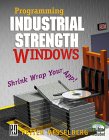Programming Industrial Strength Windows
by Petter Hesselberg
R&D Books, January 2000
528 pages, includes CD-ROM
ISBN: 087930605X
“Error handling has been omitted for clarity.”
Too many times have I read that
sentence in a programming book or article. Not that there’s anything
inherently wrong with this; simplification is a legitimate teaching
device. The problem is that the literature is terribly one-sided—it’s
a rare gem that says, “error handling has been included to show
how it’s done.” Many programmers never learn how to handle errors
and anomalies. Even more chilling, some never realize that the issue
exists. The results are all around us: robustness and reliability are
rarely considered defining characteristics of software.
This book gives you an understanding of what it takes to build
industrial strength software—software that works reliably and robustly,
software that doesn’t get between the user and his task.
It will not bestow software
nirvana
upon you; indeed, no book ever could. That unattainable state of grace can
only be approached through experience; the most a book can do is to help
you get the right rather than the wrong kind of experience. My highest
hope is that the book will inspire you to care—about your users,
about your profession and about getting the details right.
The adjective “fragmented” describes much of the computer literature.
Many books use minimalist examples to illustrate various
APIs
and subsystems, and rarely draw things together into a coherent whole.
Again, this is not necessarily a Bad Thing;
many excellent books use this approach.
Unfortunately, it is not enough.
When you assemble those fragments to create a full-blown application,
their interaction gives rise to an exponential increase in complexity,
and a myriad of details must be considered. This aspect of software
construction is rarely covered, and the litterature is left with a hole
large enough to drive a truck-full of bugs through. Sadly, bugs and
inconsistencies often are considered defining characteristics of
computer software.
This book takes a more holistic
approach; it is built around the development of a single
20,000-line application.
In addition to error handling
and application architecture, the book focuses on usability. Efficient
flow of information should receive much consideration during software
design, but the current state of the World Wide Web is proof that it
rarely receives any consideration at all. Does the user really need that
animated deodorant on his desk, or would your development effort be
better spent ensuring that the user can get his work done efficiently
and effectively, and that his data are never lost? While I like cool
stuff as well as the next programmer, I think it should be built on
solid ground rather than shifting sands.
Page xvii: The name Leif Arne Roues should be Leif Arne Rones.
Page 46: “…A subclassing function that applies yellow
backgrounds, for example, could conceivably be used for both edit controls and
list boxes. Then you’d have to store two pointers to two old window
functions…”
This does not make any sense. Change to:
“…A single window could certainly have more than one subclassing
function associated with it—one to provide a yellow background, another to
filter out illegal characters. Then you’d have to store two pointers to two old
window functions…”
(Start bottom menu)
Top •
Home
• Articles
• Book
• Resources
Windows Developer Magazine
• R&D Books
• CMP Books
Amazon.com
• Amazon.co.uk
• Contact Petter Hesselberg
(End bottom menu)

